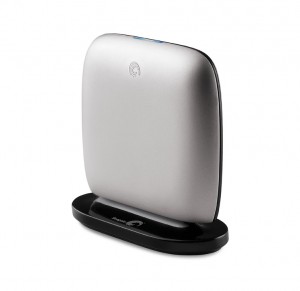Seagate Claims to be Easiest PC Backup Yet
Seagate Replica purportedly works like Apple's Time Machine
Backing up your data is one of the most important and sensible things that you can do for your computer system.
Most computer users – even savvy ones – don’t perform regular backups due to sheer laziness (I’m one of them). While companies have been selling “one-touch” backup solutions with USB hard drives for a while, the process of backing up still isn’t simple or complete enough.
Seagate believes that it has a USB external HDD that’s simple and complete enough to be the backup solution that all lazy Windows users have been waiting for. The Seagate Replica, announced today, promises that it “completely eliminates the need to manually learn, manage, or dedicate any time to the backup process.” In other words, it’s for the lazy.
The Replica is different from other backup solutions in that automatically and continuously stores and tracks all the changes in data on the main hard drive. This includes applications, e-mail, pictures, music, movies, internet bookmarks and the operating system itself with all the settings.
Boing Boing Gadgets has gone hands-on with this drive and reports that it works in a similar manner as Apple’s Time Machine function introduced in OS X Leopard: “Plugged in, its setup process was numbingly simple: agree to the TOS and you're about done. It then records a complete backup of your system and begins keeping track of changes you make. By cleverly journaling and organizing each sequential backup, the archive is unlikely to get substantially larger than the system it's attached to. As a result, you can dip into your machine's history, recover files, and restore the system in the event of disaster. It comes with a special boot CD to help in the event of the latter.”
Don’t expect all that to come cheap though, as the 500 GB model, which includes a dock, will retail for $199.99 and the 250 GB for $129.99. We’ve sent questions to Seagate on what happens if a system has more to backup than the capacities of the Replica – we’ll update the story once we get a response. Look for the Seagate Replica in May.
Get Tom's Hardware's best news and in-depth reviews, straight to your inbox.
-
Verdauga I wonder if it would work well for people that put their files in odd places. Or is it a complete drive backup? What about multiple drives?Reply
Of course...if it works as easily as they say...then it will be a good product for the lazy masses that probably include nearly all of us (me too) =D -
I'm kind of looking for backup solutions of the whole HD, that after this, will create incremental backups.Reply
And that will store incremental as well as total backups as compressed archives on the HD. (Kind of what Norton Ghost did, but without needing to have a 100GB backup for your 200GB disk where only 50GB is used. -
An easy backup requires me to plug in the drive, start the automatic program, which sets itself in the systray, background scanning my HD and updating any internal software (found on the ext. hd).Reply
Literally a system that does it all (automatically) when being connected to a pc via USB. -
joex444 It's not particularly hard to get a backup working. I think the biggest problem people face is the need for an extra drive. This costs money -- money you could spend on a graphics card, CPU or RAM.Reply
I use Acronis, and I've got about 100GB of data backed up to a 500GB eSATA drive. The ten backups (one full + 9 differential) take up about 200GB total (I used maximum compression). I have a Q6600 @ 3.3GHz, and 8GB RAM; it takes under 1 hour to back up the system and it will do it automatically. If the PC is off at the scheduled time, it pops up next login asking to run missed backups.
I've had to use the backups and restore, so glad I went out and got that 500GB drive. For backups, I would highly suggest an eSATA drive over USB / IEEE1394. I get a full 65-70MB/s on that whereas my Firewire drive can barely do 30-35, its even slower on USB. Get the eSATA, your backup won't take an hour. With USB, I bet it takes 2-3 hours. Backups are particularly intensive, as you need to go through each file, check if it exists and then check if its newer if a copy exists. eSATA greatly helps, more I/Os, more bandwidth. -
rooket But you can already buy a seagate 1tb external usb hard drive on sale for $117 at costco... odd that price of the 500gb is almost double that.Reply -
city_zen I wonder about the software they use for these solutions: is it a proprietary software or a special version of Acronis/Ghost/whatever?Reply
I'd guess the former, but I really don't know
As for me, I have two layers of backups: a "normal" backup, performed daily by SyncBackSE (excellent program, btw) and a "Disk Image" backup also performed daily by ShadowProtect Desktop, a little known piece of software that is nonetheless PCMag's Editor's choice (over Acronis, Ghost, etc.) -
computabug Back up on a Seagate? I thought we were only supposed to back up if we were ALREADY using a Seagate?Reply -
Shadow703793 I find it ironic Seagate is doing/claiming this when their HDDs are getting messed up due to firmware problems.Reply -
rooket I might be biased or clueless, but I don't like the idea of storing the firmware on the PLATTER. Come on, what if you need to actually recover the data. Swapping the controller won't help with that if the firmware is bad. Swapping the platters...ughhh... too much work for the average consumer. Looks as though possibly the 7200.12 also stores the firmware on the platter. Anyone know if WD stores it there too? I've had to RMA at least 3 seagate 7200.11's per month, that is pretty sad.Reply -
ToddAndMargo I am not sure I like this. If I goof up a file, discover it a day or so later, when I go to restore, do I find the original file or the goofed file?Reply

